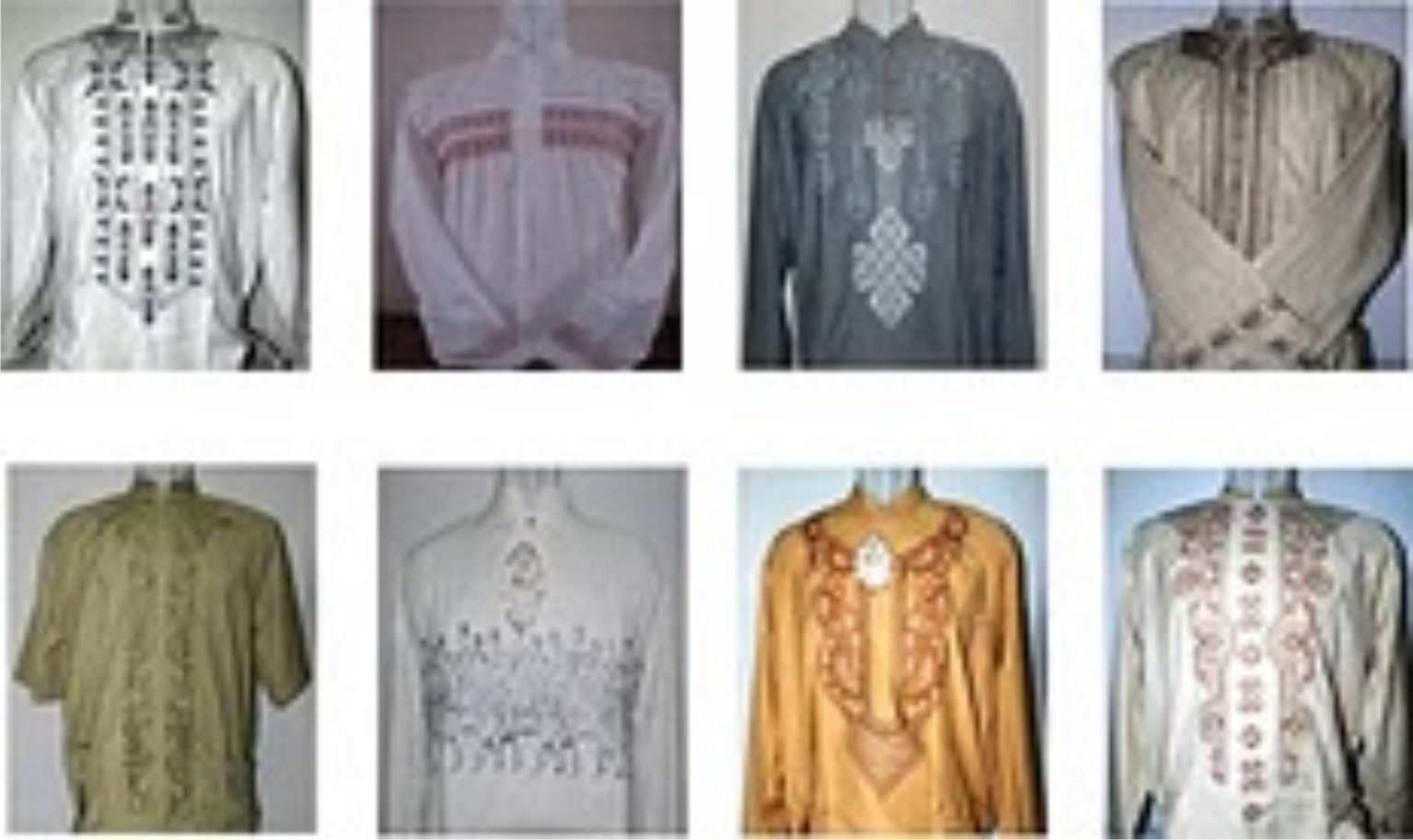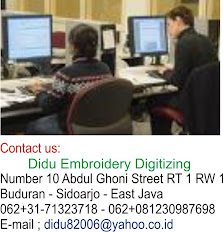Embroidery Technique
Posted on 9:38 PM | By Didu | In Embroidery Design , Embroidery Machine , Embroidery Punching

Applique - A separate, pre-cut piece of fabric that is decorated (or decorated and then cut), and applied to another piece of fabric, typically a garment. Appliqués are frequently used to reduce overall embroidery stitch counts, execute reproductions of which embroidery is impractical and decorate substrates difficult to embroider directly.
Backing - Typically non-woven material (sometimes referred to by brand name 'Pellon') applied beneath material being sewn to increase fabric stability and support stitches. Available in both tear-away and cut-away styles of various weights, backing is generally hooped with the substrate or otherwise positioned between substrate and embroidery machine throat plate prior to stitching.
Birdnesting - Typically caused by inadequate top-thread tension, top thread not following thread path, or up-and-down substrate movement under needle (see flagging), birdnesting describes an accumulation of thread between substrate and needle plate, and can result in restricted or irregular substrate travel.
Bobbin - Spool or reel that holds bobbin thread (or 'under thread') in bobbin case. Bobbin thread works with upper thread to create stitches.
Buckram or buckram lining - Heavy woven material, stiffened with glue or other substance, commonly found inside the crown of certain caps, used to lend shape to the cap; sometimes useful as substitute for other backing.
Chenille - Type of embroidery-commonly found in appliqué and athletic applications-characterized by a design surface comprised of heavy loops of thread; sewn with heavy threads or yarns, chenille is created on specialized embroidery equipment.
Column - Typically used to form borders around fill areas and for rendering text, the column stitch consists of closely spaced satin stitches.
Complex fill - Similar to standard fill, technique that allows digitizer 'knock out' area(s) within fill, creating openings or negative space (visualize Swiss cheese).
Condensed format - Digital design-storage format that allows for less limited (than expanded format) enlargement or reduction in size, scale, stitch length and density in a digitized design (within stitch-type limitations), due to proportional number of stitches being placed between pre-defined points, rather than individual stitches being assigned specific sizes; may not be read by all embroidery machines (see also expanded format).
Digitizing - Historically (and colloquially) referred to as punching, the digital means of converting artwork into the vector commands-readable by an embroidery machine's computer-that determine needle penetrations, color changes, stitch characteristics, start and stop points, etc.
Digitizing tablet - The platen or surface on which original art to be digitized is placed; holds the artwork flat, allowing digitizer to specify various design characteristics (see digitizing) by 'tracing' and otherwise designating them with a digitizing 'puck' (input device similar to a computer mouse).
Editing - Limited form of digital design manipulation that typically allows user to edit stitches or blocks of stitches, incorporate text, scale up or down, reposition design elements, add, delete and modify machine commands, etc.
Emblem - Commonly an insignia, crest or patch-often applied via appliqué-characterized by a finished, sewn border that contains text and/or design elements.
Embroidery - Decorative sewing on fabric or other substrate that incorporates design elements, text or other recognition, commercial or promotional graphics; originally executed by hand, embroidery has evolved through various stages of technology to its current state of computer-driven, multi-head, multi-color embroidery machines.
Expanded format (see also condensed format) - Digital design-storage format that assigns individual stitches specific sizes; selection of this format typically restricts user's ability to scale a design up or down because stitch counts remain constant regardless of final design size.
Fill - Large design area typically covered by series of running stitches, the pattern of which may be varied in terms of stitch length, angle and density.
Finishing - Any of a number of procedures-thread trimming, removal of excess backing or topping, spot or soil removal or steaming to remove hoop marks-that are performed between completion of embroidery and packaging for customer.
Flagging - As needle moves up and down, substrate may also move up and down against the machine bed (resembling a waving flag), causing birdnesting and poor design registration; typically due to poor presser-foot adjustment or improperly stabilized fabric.
Hook or rotary hook - A circular device which spins around the bobbin case with a pointed arm protruding from its body-the hook; is instrumental, in concert with the needle and upper thread, in forming stitches.
Hook timing - Proper synchronization of hook's rotary and needle's up/down movement; necessary to form stitches.
Hoop or frame - Device used to stabilize the fabric in that area of substrate to be embroidered; typically composed of two concentric, wood or plastic rings, the inner of which fits tightly within the outer-with the fabric in between-stabilizing the fabric and holding it in close contact with the machine bed during embroidery.
Hooping aid or hooping station - A device used to aid in the hooping process, generally by holding the substrate and/or hoop as the rings are engaged, in order to enhance hooping efficiency and consistency.
Lock stitch - Sometimes referred to as a tack or lock-down stitch, it is typically found at the conclusion of elements such as fills and columns, or prior to color changes or stop points.
Looping - Erratic stitch construction-often due to improper top-thread tension-resulting in loops on the surface of the embroidery.
Monogram - Sewn or embroidered design consisting of stylized letters-typically three or fewer-that represent the initial(s) of a person or organization.
Needle - Slender piece of steel with a point, ball, taper or other shape on one end-to facilitate penetration of various fabric types-and a nearby hole (or eye) for thread to pass through.
Nippers - Small, scissors-like cutting tool specifically designed for thread trimming, during finishing of embroidery
Pencil transfer - Least expensive 'proofing' method performed by lightly rubbing a soft-leaded pencil on tracing or tissue paper placed over embroidery sample.
Puckering - Gathering of fabric due to its tension being less than that of stitches; typically due to improper thread tension, inadequate hooping or inappropriate backing.
Pull compensation - Deliberate distortion digitized into a design to compensate for thread pull that would otherwise cause a 1-cm stitch (for example) to shrink to a .9-cm stitch, due to thread tension.
Registration - The proper relationship and alignment of all colors, stitches and other elements in a design.
Running stitch - Sometimes called 'walking' stitch, used for fine detail, outlining, and quickly covering space between separate design elements; used primarily for underlay.
SPM - Stitches-per-minute measurement used to rate embroidery machine production speed.
Satin stitch - Closely spaced stitches, similar to zigzag, except that they alternate between straight stitches and angled stitches (rather than all angled) of varying length, angle and density.
Scaling - Proportionately enlarging or reducing all elements in a digitized design.
Scanner - Means of converting artwork-either transmissive or reflective-into digital format, to then be further digitized or edited via computer.
Short-stitch filter - Digitizing-program feature that eliminates stitches shorter than a predetermined length, to reduce thread breaks.
Short stitching - Deliberately shorter stitches incorporated by digitizer to compensate for increasing stitch density in corners and curves.
Special fill - A function available in some digitizing software that automatically incorporates special patterns or textures into fill areas.
Stitch editing - The alteration of one or more stitches in an embroidery design, accomplished as a function of digitizing or editing.
Stock design - Similar to clip art, a 'generic' embroidery design available in digital format at a lower cost than a custom-digitized design.
Tackle twill - Text characters cut from twill fabric with an adhesive backing; typically used for athletic applications, the backing allows the character to be tacked in place-appliqué-wise-then its edges finished with zigzag stitches.
Tape - Archaic (rendered largely obsolete by digital technology) means of storing embroidery-design information on a paper (or other medium) tape with holes actually punched through its surface which are then 'read' by an automatic embroidery machine; sometimes used colloquially as a synonym for 'diskette.'
Tension - Proper top- and under-thread tension is critical in the correct formation of stitches (in some cases, adequate tension may be quickly assessed by examining the underside of an embroidery and observing a 1:2 ratio of bobbin thread to top thread).
Thread - Typically a fine-gauge synthetic-but also of natural materials, for certain applications-cord used for embroidery stitching; made of two or more filaments twisted together for strength and other characteristics; available in a wide array of colors and performance attributes, as well as various specialty threads (such as metallic).
Topping - Sometimes known as 'facing,' a material placed on top of the substrate fabric prior to embroidery-either hooped or otherwise held in place-intended to neutralize fabric-surface characteristics such as the heavy nap of fleece, or the wales of corduroy; after embroidery, excess topping is removed either manually, or through the application of heat or water.
Trimming - The removal of excess stitches, thread ends and backing during the finishing process.
Underlay - Stitches applied prior to other design elements to either A) neutralize fabric-surface characteristics (see also topping); or B) to create special design effects such as depth and dimensionality.
Zigzag - Stitches that progress in an alternating-angle (zigzag) fashion; typically used for final stitching on appliqué and tackle twill.




















Comments (2)
Post a Comment